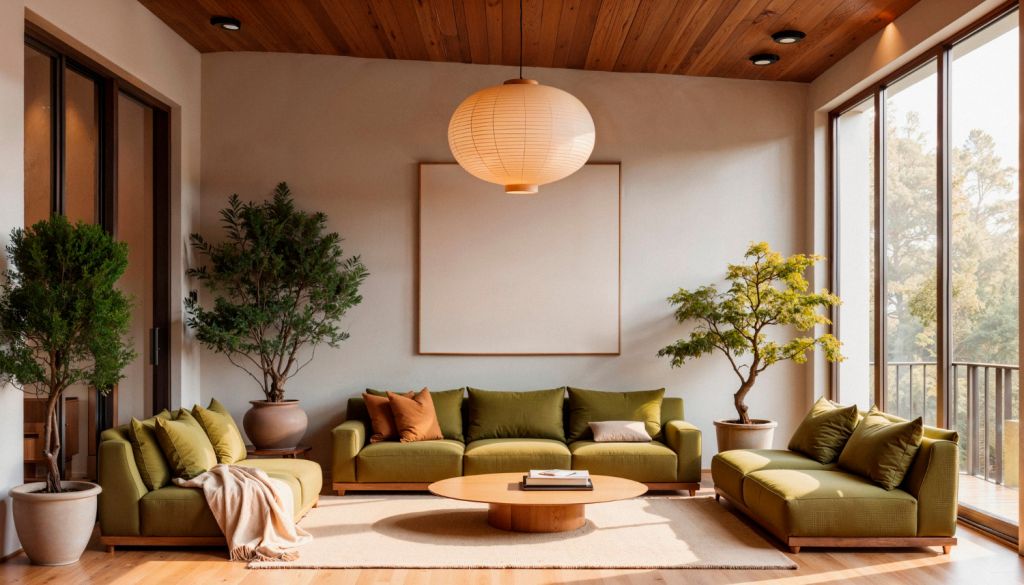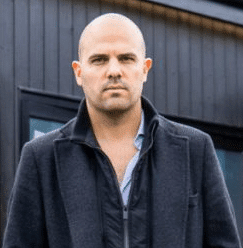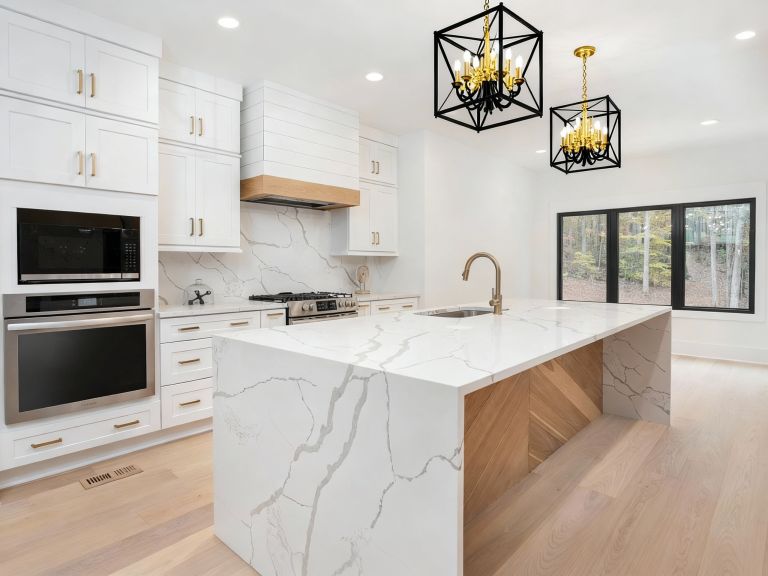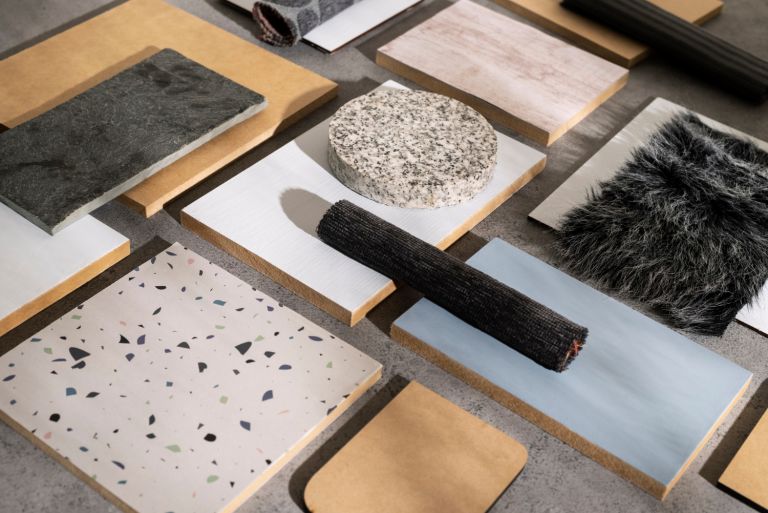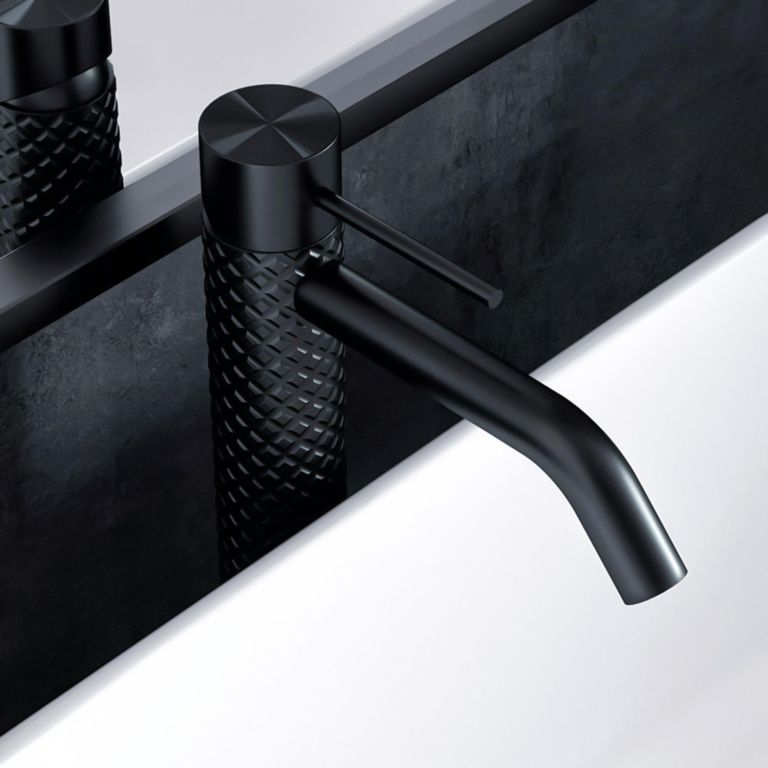Walking through the Sausalito home I just completed, you’d immediately notice something different about how it feels compared to the Instagram-perfect spaces that dominated the past few years.
Gone are the stark white walls and industrial-cold minimalism. Instead, warm terracotta accents frame hand-plastered walls in soft sage green. Natural linen curtains filter golden afternoon light across furniture pieces that look like they were crafted by artisans rather than mass-produced. A living wall of native California plants creates a backdrop for the dining area, while the kitchen features unlacquered brass hardware that’s already developing a beautiful patina.
This shift represents something fundamental happening in California interior design: we’re moving from spaces that photograph well to spaces that actually support how we live, work, and find peace in our homes.
After completing over 180 interior design projects across California in 2024, I’ve identified the key trends that are reshaping how we think about home design. These aren’t fleeting fashion moments, but responses to deeper cultural shifts – our relationship with technology, our need for wellness-focused environments, and our growing appreciation for authentic craftsmanship over mass-market perfection.
The trends defining 2025 reflect California’s unique culture: environmental consciousness, wellness focus, indoor-outdoor living, and appreciation for both innovation and authenticity. They’re practical responses to how we actually live rather than how we think we should live.
From Marin County to Manhattan Beach, the most forward-thinking California homes are embracing design approaches that feel both utterly contemporary and timelessly connected to our state’s natural beauty and laid-back luxury aesthetic.
Let me show you exactly which trends are reshaping California interiors and how to implement them in ways that feel authentic to your lifestyle and location.
Trend 1: Warm Earth Tones Replace Cool Grays
The cold, industrial palette that dominated the 2010s is giving way to colors that feel grounding, optimistic, and connected to California’s natural landscape.
After years of gray-everything, California homeowners are embracing color palettes that reflect our state’s diverse geography – from the warm adobe tones of Southern California to the sage greens of our coastal hills.
The Psychology Behind the Shift
Why warm earth tones are resonating now:
Post-pandemic comfort seeking: Soft, warm colors create psychological comfort and reduce stress in homes that serve multiple functions
Biophilic design influence: Earth tones connect interior spaces to natural environments, supporting wellness and mental health
Rejection of perfectionism: Warmer colors feel more forgiving and livable than stark white spaces that show every fingerprint
California identity: Colors that reflect our state’s landscape create authentic sense of place
Key Color Families Trending in 2025
Terracotta and clay tones:
- Warm terracotta: Perfect accent color for feature walls and architectural details
- Clay pink: Sophisticated alternative to millennial pink that works with natural materials
- Adobe cream: Neutral base that provides warmth without overwhelming small spaces
- Best applications: Dining rooms, powder rooms, exterior accents
Sage and olive greens:
- Sage green: Calming color that works beautifully with natural wood and stone
- Olive green: Sophisticated alternative to forest green that feels both classic and fresh
- Eucalyptus: Gray-green that bridges cool and warm palettes
- Best applications: Bedrooms, home offices, kitchen cabinetry
Warm neutrals with personality:
- Mushroom: Rich beige with gray undertones that feels sophisticated
- Oatmeal: Cream color with texture and depth
- Warm white: Off-whites with yellow or pink undertones instead of blue
- Best applications: Primary wall colors, ceiling treatments, built-in cabinetry
Implementation Strategies
Gradual color introduction:
- Start with accessories and textiles to test color comfort level
- Use earth tones as accent colors against neutral backgrounds
- Consider seasonal color changes through pillows, throws, and artwork
Color zoning:
- Use different earth tones to define functional areas in open floor plans
- Create color flow between adjacent rooms through coordinated palettes
- Balance warm and cool tones to prevent spaces from feeling too monochromatic
California-specific applications:
- Pair earth tones with natural materials popular in California homes
- Use colors that complement outdoor views and landscape
- Consider how colors will look in California’s intense natural light
Trend 2: Handcrafted and Artisan-Made Everything
Mass-produced perfection is being replaced by handmade objects that tell stories and bring authentic human touch to interior spaces.
This trend reflects a growing appreciation for craftsmanship, sustainability, and supporting local artisans – values that strongly resonate with California’s maker culture and environmental consciousness.
The Artisan Movement in California Design
Why handcrafted elements are trending:
Authenticity seeking: In an increasingly digital world, handmade objects provide tangible connection to human creativity
Sustainability values: Handcrafted items typically use sustainable materials and production methods
Unique character: Artisan-made pieces ensure homes don’t look like catalog showrooms
Local economy support: California has incredible maker communities that homeowners want to support
Key Handcrafted Elements Trending
Custom pottery and ceramics:
- Hand-thrown vases and planters: California pottery studios creating unique pieces
- Custom tile work: Handmade tiles for backsplashes and bathroom features
- Artistic lighting fixtures: Ceramic pendant lights and table lamps
- Cost range: $50-500 for pottery, $15-40 per square foot for handmade tiles
Artisan textiles:
- Hand-woven rugs: California textile artists creating contemporary designs
- Block-printed fabrics: Pillows and window treatments with artisan patterns
- Macramé wall hangings: Modern interpretations of 1970s craft techniques
- Cost range: $300-2,000 for custom rugs, $50-200 for textile accessories
Custom woodworking:
- Live-edge furniture: Tables and benches showcasing natural wood character
- Hand-carved architectural details: Custom millwork with artisan touches
- Reclaimed wood installations: Accent walls and shelving from California timber
- Cost range: $500-5,000 for custom furniture, $25-75 per square foot for installations
Metal artisan work:
- Hand-forged hardware: Cabinet pulls, door handles, and light fixtures
- Custom metalwork: Stair railings, fireplace screens, and decorative panels
- Artistic sculptures: Three-dimensional art pieces integrated into design
- Cost range: $25-150 per hardware piece, $200-2,000 for custom installations
Supporting California Artisans
Local maker communities:
- Bay Area: Rich tradition of ceramics, textiles, and woodworking
- Los Angeles: Strong furniture design and metalworking communities
- Central Coast: Pottery and textile artisans inspired by coastal landscape
- Wine Country: Artisans creating pieces for hospitality and residential markets
Sourcing strategies:
- Visit local art shows and maker markets for direct artist relationships
- Work with interior designers who have established artisan networks
- Commission custom pieces that reflect personal style and home architecture
- Budget 10-20% of interior design budget for artisan and handmade elements
Trend 3: Maximalist Minimalism
The stark minimalism of recent years is evolving into a more sophisticated approach that celebrates carefully curated collections and personal expression.
This trend allows for more personality and comfort while maintaining the clean, uncluttered aesthetic that works well in California’s bright, outdoor-focused lifestyle.
Defining Maximalist Minimalism
Core principles:
- Quality over quantity: Fewer pieces, but each one exceptional and personally meaningful
- Curated collections: Thoughtful displays of art, books, and objects that tell personal stories
- Layered textures: Multiple textures and materials creating visual richness without clutter
- Purposeful color: Bold colors used strategically rather than throughout entire spaces
How it differs from traditional minimalism:
- Personality allowed: Spaces reflect individual interests and experiences
- Comfort prioritized: Furniture selected for livability, not just visual impact
- Collections celebrated: Books, art, and personal objects displayed rather than hidden
- Imperfection embraced: Lived-in feeling preferred over showroom perfection
Key Elements of the Trend
Statement art and collections:
- Gallery walls: Curated art collections displayed thoughtfully
- Book displays: Beautiful books as decorative and functional elements
- Sculpture integration: Three-dimensional art pieces as focal points
- Personal collections: Vintage finds, travel souvenirs, and meaningful objects
Layered lighting:
- Multiple light sources: Combination of ambient, task, and accent lighting
- Statement fixtures: Bold light fixtures as sculptural elements
- Natural light emphasis: Window treatments that maximize California sunshine
- Flexibility: Lighting that adapts to different activities and times of day
Rich material palettes:
- Mixed metals: Gold, brass, black iron, and copper used together thoughtfully
- Varied wood tones: Different wood species and finishes creating depth
- Stone and marble: Natural stone in multiple applications and finishes
- Textile variety: Linen, wool, silk, and cotton in complementary colors and patterns
Implementation in California Homes
Indoor-outdoor integration:
- Collections that work both inside and outside
- Materials that handle California’s varied climate conditions
- Plant integration as living art and collections
- Outdoor spaces treated with same design attention as interiors
Natural light considerations:
- Colors and materials selected for how they look in bright California light
- Window treatments that provide flexibility for different light conditions
- Artwork and collections positioned to take advantage of natural lighting
- Reflective surfaces used to multiply natural light effects
Trend 4: Wellness-Focused Design Elements
Interior design is increasingly viewed as a tool for supporting physical and mental health, with specific elements chosen for their wellness benefits.
California’s leadership in wellness culture is driving design decisions that prioritize air quality, natural light, stress reduction, and connection to nature.
The Science of Wellness Design
Research-backed design elements:
- Biophilic design: Natural elements that reduce stress and improve cognitive function
- Circadian lighting: Light systems that support healthy sleep-wake cycles
- Air quality improvement: Materials and plants that filter indoor air
- Stress-reducing colors: Colors proven to lower cortisol levels and promote calm
Key Wellness Design Elements
Indoor air quality optimization:
- Low-VOC materials: Paints, finishes, and furnishings that don’t off-gas harmful chemicals
- Natural ventilation: Operable windows and cross-ventilation for fresh air circulation
- Air-purifying plants: Strategic placement of plants known for air filtration properties
- Advanced filtration: HVAC systems with high-quality air filtration
- Cost impact: 5-10% additional for premium materials and systems
Natural light maximization:
- Larger windows: Expanding existing windows or adding new ones for daylight
- Skylights and light tubes: Bringing natural light to interior spaces
- Light-colored surfaces: Walls and ceilings that reflect and amplify natural light
- Automated window treatments: Systems that adjust based on time of day and season
- Cost impact: $200-800 per square foot for window additions
Stress reduction through design:
- Organic shapes: Furniture and architectural elements with curved, natural forms
- Water features: Indoor fountains and water elements for soothing sounds
- Comfortable seating: Furniture designed for relaxation and stress relief
- Quiet zones: Designated spaces for meditation, reading, and restoration
- Cost impact: $5,000-25,000 for comprehensive wellness upgrades
Sleep optimization:
- Bedroom air quality: Special attention to materials and ventilation in sleeping areas
- Blackout capabilities: Window treatments that create complete darkness for sleep
- Noise control: Sound-dampening materials and design for better sleep quality
- Temperature control: Zoned HVAC systems for ideal sleeping temperatures
- Cost impact: $3,000-15,000 for bedroom wellness optimization
Trend 5: Indoor-Outdoor Boundary Dissolution
The line between interior and exterior spaces continues to blur, with design elements that create seamless transitions and year-round outdoor living.
California’s favorable climate makes this trend particularly relevant and achievable, transforming how we think about usable living space.
Seamless Integration Strategies
Material continuity:
- Flooring transitions: Same materials flowing from indoor to outdoor spaces
- Color palette extension: Interior colors repeated in outdoor furniture and landscaping
- Architectural consistency: Design elements that work both inside and outside
- Plant integration: Outdoor plants visible from interior spaces, indoor plants on patios
Flexible space planning:
- Movable furniture: Pieces that can be used indoors or outdoors as needed
- Convertible spaces: Rooms that open completely to outdoor areas
- Weather protection: Retractable awnings and screens for year-round use
- Storage solutions: Outdoor storage that doesn’t compromise design aesthetic
Technology Integration
Automated systems for seamless living:
- Motorized doors and windows: Large openings that disappear at the touch of a button
- Climate control: Heating and cooling systems that work for indoor-outdoor spaces
- Lighting systems: Coordinated lighting that extends from interior to exterior
- Audio integration: Sound systems that provide seamless indoor-outdoor entertainment
Smart home features:
- Weather-responsive systems: Automated closing of windows and doors during rain
- Security integration: Cameras and sensors that work for both indoor and outdoor areas
- Irrigation coordination: Garden watering systems integrated with home automation
- Cost impact: $15,000-50,000 for comprehensive indoor-outdoor automation
Trend 6: Sustainable Luxury Materials
High-end materials are increasingly chosen for their environmental credentials as well as their aesthetic appeal.
California’s environmental consciousness is driving demand for luxury materials that are both beautiful and sustainable.
Sustainable Material Categories
Reclaimed and recycled luxury:
- Reclaimed hardwood: Vintage wood from California barns and industrial buildings
- Recycled glass surfaces: Countertops and tiles made from recycled glass
- Reclaimed stone: Architectural salvage stone for feature walls and fireplaces
- Recycled metal accents: Hardware and fixtures made from recycled materials
- Cost impact: Often comparable to new materials, sometimes premium pricing
Rapidly renewable materials:
- Bamboo flooring: Fast-growing alternative to traditional hardwood
- Cork flooring and walls: Renewable material with unique texture and properties
- Hemp and linen textiles: Natural fibers for upholstery and window treatments
- Seagrass and jute rugs: Natural fiber floor coverings
- Cost benefit: Often 10-20% less expensive than traditional luxury materials
Local and regional materials:
- California hardwoods: Locally harvested oak, maple, and other native species
- Regional stone: Sonoma fieldstone, Monterey limestone, and other local materials
- Local ceramics: Tiles and pottery made by California artisans
- Native plant integration: Landscaping with California native species
- Cost impact: Reduced transportation costs often offset premium local pricing
Certification and Verification
Third-party certifications:
- FSC-certified wood: Forest Stewardship Council verification of sustainable harvesting
- Cradle to Cradle certified: Materials assessed for entire lifecycle impact
- GREENGUARD certification: Low-emission materials for better indoor air quality
- Energy Star ratings: Appliances and systems with verified efficiency ratings
Transparency and sourcing:
- Supply chain documentation: Understanding where materials come from
- Carbon footprint analysis: Choosing materials with lower environmental impact
- End-of-life planning: Materials that can be recycled or composted at end of use
- Local sourcing priority: Reducing transportation impact through regional purchasing
How to Implement 2025 Trends Successfully
Strategic approach to incorporating trending elements while maintaining timeless appeal and personal style.
Trend Integration Strategy
Start with foundational elements:
- Choose neutral base palette that works with trending accent colors
- Invest in quality basic furniture that can be updated with trending accessories
- Focus on architectural elements that support multiple trend directions
- Plan flexibility for changing accent colors and decorative elements
Layer trends gradually:
- Implement one major trend per room or project phase
- Test trending colors through temporary elements before committing to permanent features
- Balance trending elements with timeless classics
- Leave room for personal preferences and lifestyle needs
California-specific considerations:
- Choose trends that complement California’s natural light and climate
- Consider how trending elements work with indoor-outdoor lifestyle
- Select materials that age well in California’s varied weather conditions
- Ensure trends align with local architectural styles and neighborhood character
Budget Allocation for Trending Elements
Cost-effective trend implementation:
High-impact, low-cost changes (Under $5,000):
- Paint colors in trending earth tones
- Textile updates with artisan-made pillows and throws
- Lighting fixture updates with handcrafted pieces
- Plant additions for biophilic design elements
Medium investment updates ($5,000-25,000):
- Custom tile work in trending colors and patterns
- Artisan furniture pieces as statement elements
- Window treatment updates for indoor-outdoor integration
- Air quality improvements for wellness design
Major renovation integration ($25,000+):
- Kitchen and bathroom updates incorporating trending materials
- Architectural modifications for seamless indoor-outdoor living
- Comprehensive lighting design with wellness features
- Custom millwork and built-ins reflecting artisan aesthetics
Avoiding Trend Fatigue
Timeless implementation strategies:
- Use trending colors as accents rather than dominant themes
- Choose handcrafted pieces with classic proportions and quality construction
- Focus on wellness elements that provide long-term benefits regardless of trends
- Invest in flexible systems that can evolve with changing preferences
Personal style integration:
- Adapt trends to reflect individual preferences and lifestyle needs
- Consider family dynamics and how trends support daily living
- Maintain elements that have personal meaning regardless of current trends
- Create unique combinations that reflect personal aesthetic rather than following trends exactly
Regional Variations Across California
How 2025 trends manifest differently across California’s diverse regions and microclimates.
Northern California Applications
Bay Area characteristics:
- Earth tones that complement fog and natural landscape
- Artisan integration reflecting strong maker communities
- Wellness focus addressing high-stress lifestyle
- Indoor-outdoor design adapted to microclimates
Wine Country adaptations:
- Sophisticated earth tones reflecting vineyard landscape
- Artisan elements supporting local wine and hospitality culture
- Luxury sustainable materials appropriate for hospitality
- Seamless integration with outdoor entertaining spaces
Southern California Interpretations
Los Angeles area:
- Brighter earth tones reflecting desert landscape
- Artisan elements with international influences
- Maximalist minimalism reflecting entertainment industry aesthetic
- Extensive indoor-outdoor integration for year-round outdoor living
San Diego region:
- Coastal-influenced earth tones and materials
- Sustainable luxury reflecting environmental consciousness
- Wellness design supporting active outdoor lifestyle
- Indoor-outdoor design optimized for consistent mild climate
Central Coast Considerations
Material selection:
- Earth tones reflecting coastal hills and agricultural landscape
- Local artisan integration supporting regional maker communities
- Sustainable materials appropriate for coastal environmental conditions
- Weather-appropriate indoor-outdoor integration for variable coastal climate
Final Results
2025 interior design trends for California homes represent a maturation of design thinking that prioritizes wellness, authenticity, and connection to place while maintaining the sophisticated aesthetic that defines California luxury living.
Successful trend implementation typically achieves:
- Spaces that feel both current and timeless rather than trendy
- Improved wellness and comfort through scientifically-backed design elements
- Enhanced connection to California’s natural environment and cultural values
- Support for local artisans and sustainable business practices
- Flexible designs that can evolve with changing needs and preferences
- Authentic personal expression rather than catalog-perfect conformity
The key to success is understanding that trends should enhance rather than define your home’s character, supporting your lifestyle while reflecting broader cultural shifts toward wellness, sustainability, and authentic living.
Conclusion
The interior design trends shaping California homes in 2025 reflect our state’s unique culture and values: environmental consciousness, wellness focus, appreciation for craftsmanship, and seamless indoor-outdoor living.
These aren’t superficial style changes, but deeper shifts toward creating homes that actively support how we want to live, work, and find peace in an increasingly complex world.
The most successful implementations feel authentic rather than forced, supporting individual lifestyle needs while connecting to broader cultural movements toward sustainability, wellness, and local community support.
For California homeowners, these trends offer opportunities to create spaces that feel both utterly contemporary and deeply connected to our state’s natural beauty, creative culture, and innovative spirit.
The investment in trending design elements pays dividends through enhanced daily comfort, improved wellness outcomes, support for local economies, and homes that feel authentically connected to the unique character of California living.


